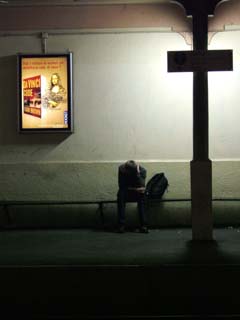 |
To the French, Paris is still the center of the art
world. It was time to find out if they are right.
|
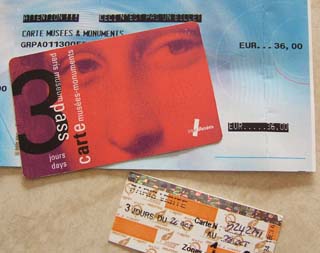
|
There is a special
pass "Carte Musees et Monuments" that allows entry into over sixty
museums and monuments around town. Seemed like a good deal so I
got one. Below it is my Metro Pass. Between the two I hoped
to
be free to go to any museum in town. As it turned out, there are
many more than sixty museums and monuments around Paris but I had to
start somewhere.
|
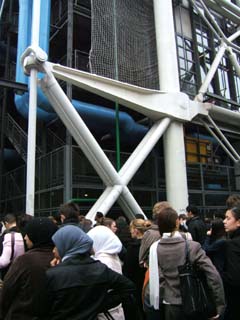
|
Centre George
Pompidou. I waited in this line for over an hour only to
find that it was the wrong one. No problem, I was directed to the
right line to wait again. The French seem to delight in making
people wait for them and treat a line as a sort of pet that must be
continuously fed.
|
 |
Wary, I left my place
to ask the man in charge of letting people out. He was pleased to
inform me that
my museum pass
was no good for the "special" exhibit and directed me to a third
line to buy a different ticket. I never found out what the
first line was for. It took three hours to get into the Dada
exhibit. If I had known what I was doing, and timed things right,
it would have taken about 30 minutes. |

|
I wasn't allowed to
take pictures of the pieces in the Dada exhibit and there was even a
special guard to enforce this with respect to the famous toilet by
Marcel Duchamp. This piece, is a replica of the off-the-shelf
urinal that was
sarcastically entered in a big art show. The original was tossed
out by the art show. The ensuing scandal was
enough to cause this piece to be chosen by most art experts as THE most
significant piece of art of the twentieth century. The irony
never ceases. Here is a piece that was entered partly in protest
of the elitist art world and has since become the symbol of the elite
art world; it is not the original, it was not created by the artist who
gets credit for it
becoming so significant yet its image is now owned and so valuable
that a full time guard was placed to keep anyone from subverting the
copyright.
Consider this illicit image of a copyrighted image of a
reproduction of the randomly chosen copy
of a once common item taken out of the mundane and made famous by the
mere selection by "R. Mutt" to be my contribution to the legacy of
Dada. If anyone would be so kind as to threaten to sue me for
subverting the "Elite Art World" I would
be delighted to rise into notoriety for a similar minimal amount of
effort. I think that many enjoy the irony that the most
significant work of art of the twentieth century is something you are
supposed to piss on. That's probably the real reason for the
guard. It is just too tempting. After all, it was entered
as "The Fountain".
(Post note: Jan 6 2006. I read an article today confirming
my suspicion for the guard. A performance artist tried to perform
with this device in 1993 and then returned in 2006 with a hammer.
He claimed his efforts would have pleased Duchamp.)
|
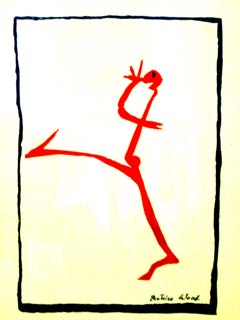
|
The Dada exhibit was
great. Worth the wait. In one event I was able to view a
substantial portion of the work done during the brief eight or
nine years that Dada was the big fashion. But calling it a
fashion is both accurate and misleading. My conclusion was that
it was born of the same desire for newness that inspired the Futurists
but with a strong distaste, born of direct experience, for
violence. Much of the rest of what
has taken place in art since then, and a great portion of my confusion
about art, can be traced to the transition that was accomplished with
the Dada movement. The participating artists embraced
randomness and celebrated the resulting confusion as the successful
consequence. Most of the perpetrators were young at the time and
testing
their strength against the establishment. It is ironic that
revolt against tradition has become the
enduring tradition in contemporary art.
There were over a thousand pieces in the show which included
works by painters, sculptors, film
makers, poets, writers and musicians. I would be hard pressed to
describe any one work or artist as being representative of the
whole. Yet the method of creating: the deliberate breaking
of boundaries, of using the mundane as if it were precious, of
accepting randomness has been
repeatedly used to create new "avante guarde" art forms. Even the
natural suspicion that a supposedly random choice might be fueled by
some subconscious motivation was explored and emerged as Surrealism.
The systematic attack on anything successful or established is
suited to a society that worships youth but I wonder if nearly a
hundred years of running
away from overt meaning in art is enough.
|

|
The permanent exhibit space
of the Pompidou Center suffered in comparison. The collection was
substantial but it was
organized for grammar school kids into common topics like "color" or
"size" or "space". There is a great view from the sixth floor
sculpture garden though. I don't know what was on the second
through fifth floors as they were closed to the public.
|
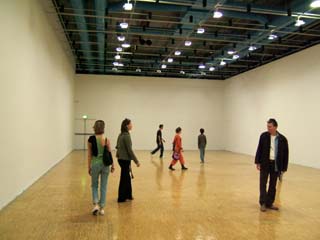
|
The entry level of the
main building has
the usual spaces for standing in
line to buy tickets or browsing through the bookstore but there was
also an
exhibition space. An "Invisible Labyrinth", by Jeppe Hein" was
navigable by wearing a head set that vibrated whenever it passed
through a "wall". It was a simple IR detector that drove a cell
phone type vibrator whenever it passed under an active IR
transmitter. You can see the array of black cans containing IR
transmitters on the ceiling. The resolution was a bit coarse but
it was a nice idea and people seemed to enjoy it despite the "walls"
changing position as you tilted or turned your head without
moving. I expect this idea will be explored further with better
equipment. I find it tempting myself.
|
 |
Outside of the main
Pompidou Center building is a reconstruction of
Constantin Brancusi's studio. Like many of the great masters, he
spent
a good deal of his last years preparing his legacy and donated his
collection of works to France under the condition that they keep his
studio exactly as he had left it. |
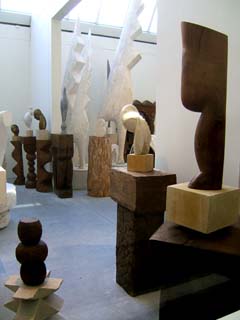 |
The French
compromised and made a special glass-enclosed replica so
that visitors could peer in through the windows without disturbing
anything. The heavy layer
of
marble dust is gone but most of the pieces look like they have been
arranged pretty much as they were in photographs that he took.
|
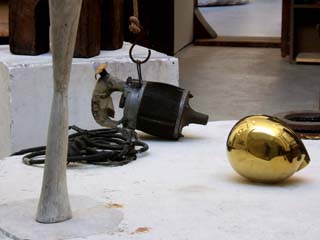
|
Power tools,
then newly available, are a
critical factor in Brancussi's work in my view. They allowed him
to explore a very high
degree
of polish and perfection to the point of obsession. It is telling
that
he worked with relatively few separate forms and continued to refine
them to their essence. His way of blending
the modern and the primitive makes him one of my favorites . |
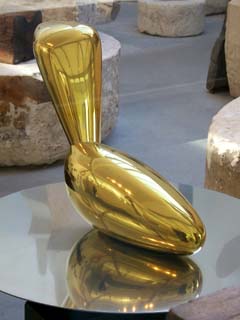 |
The piece that I most
wanted to see was "Leida" in which Brancussi
was attempting to present the myth of a woman transforming into a
swan. I see it as follows: the upper shape is her torso partially
transformed into the neck of the swan. The lower portion is the
body of the swan but the reflection of the horizontal corner of
the
room makes the piece look like a woman seated on her knees. I am
intrigued with his work with reflections and am beginning to see why he
was so concerned with both the perfection of the surfaces and with the
relative
placement of his completed pieces. This piece and several others
are supposed to be
rotating so that the reflections of the room change but none were not
operating.
|
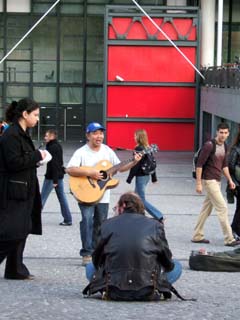 |
Perhaps the most
vibrant
part of the Pompidou Center was the courtyard in front of the building
where people came to relax and listen to street musicians.
This guy in the NY cap sang pop songs with a strong Korean-American
accent. (My favorite was "tay me home, bear I belon.
Wesbaginia". He was a big hit with the young French girls as he
sang "Cain't Get No, Satisfaction".
|
|
|












